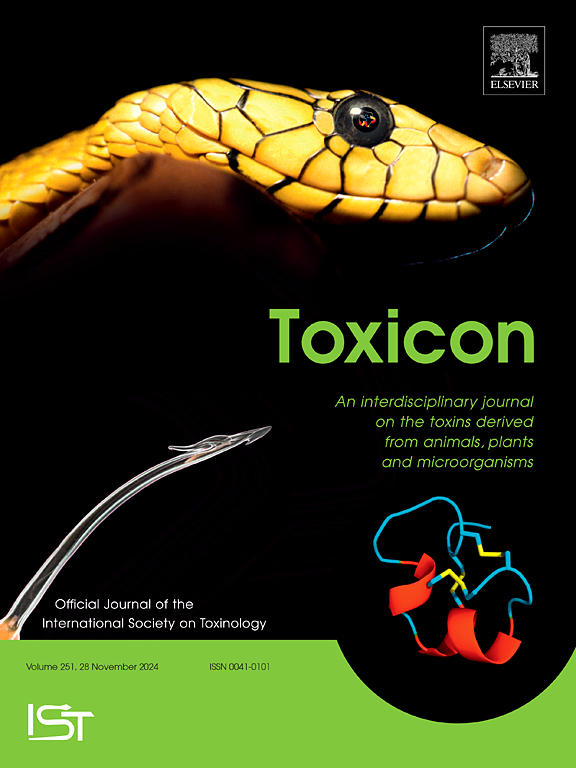Latrodectus spp. toxins outside venom glands: past, present and future
IF 2.6
4区 医学
Q2 PHARMACOLOGY & PHARMACY
引用次数: 0
Abstract
Latrodectus spp. are one of the highly poisonous spiders known in the world. Interestingly, the spiders not only produce and secrete toxins by their venom glands, but also have toxic components in other parts of the adult spiders, and even in the newborn spiderlings and unhatched eggs. The venom and venom toxins secreted by their venom glands have been quite extensively studied and, comparatively, the study on the toxins outside venom glands is limited. Although the toxins outside venom glands were discovered at a very early time, it is not until recently that the molecular basis and mechanism of the toxicity outside venom glands have been relatively systematically investigated, which have significantly expanded our understanding of the spider toxins. This review summarizes the progresses in research on Latrodectus spp., particularly black widow spider, toxins outside venom glands, with an emphasis on toxins from the spider eggs.
毒腺外毒素:过去、现在和未来。
Latrodectus是世界上已知的剧毒蜘蛛之一。有趣的是,蜘蛛不仅通过它们的毒腺产生和分泌毒素,而且在成年蜘蛛的其他部位,甚至在新生蜘蛛和未孵化的蜘蛛卵中也有有毒成分。它们的毒腺分泌的毒液和毒液毒素已经得到了相当广泛的研究,相比之下,对毒腺外毒素的研究还很有限。虽然在很早的时候就发现了毒腺外毒素,但直到最近才比较系统地研究了毒腺外毒性的分子基础和机制,极大地扩展了我们对蜘蛛毒素的认识。本文综述了黑寡妇蜘蛛毒腺外毒素的研究进展,重点介绍了黑寡妇蜘蛛卵毒素的研究进展。
本文章由计算机程序翻译,如有差异,请以英文原文为准。
求助全文
约1分钟内获得全文
求助全文
来源期刊

Toxicon
医学-毒理学
CiteScore
4.80
自引率
10.70%
发文量
358
审稿时长
68 days
期刊介绍:
Toxicon has an open access mirror Toxicon: X, sharing the same aims and scope, editorial team, submission system and rigorous peer review. An introductory offer Toxicon: X - full waiver of the Open Access fee.
Toxicon''s "aims and scope" are to publish:
-articles containing the results of original research on problems related to toxins derived from animals, plants and microorganisms
-papers on novel findings related to the chemical, pharmacological, toxicological, and immunological properties of natural toxins
-molecular biological studies of toxins and other genes from poisonous and venomous organisms that advance understanding of the role or function of toxins
-clinical observations on poisoning and envenoming where a new therapeutic principle has been proposed or a decidedly superior clinical result has been obtained.
-material on the use of toxins as tools in studying biological processes and material on subjects related to venom and antivenom problems.
-articles on the translational application of toxins, for example as drugs and insecticides
-epidemiological studies on envenoming or poisoning, so long as they highlight a previously unrecognised medical problem or provide insight into the prevention or medical treatment of envenoming or poisoning. Retrospective surveys of hospital records, especially those lacking species identification, will not be considered for publication. Properly designed prospective community-based surveys are strongly encouraged.
-articles describing well-known activities of venoms, such as antibacterial, anticancer, and analgesic activities of arachnid venoms, without any attempt to define the mechanism of action or purify the active component, will not be considered for publication in Toxicon.
-review articles on problems related to toxinology.
To encourage the exchange of ideas, sections of the journal may be devoted to Short Communications, Letters to the Editor and activities of the affiliated societies.
 求助内容:
求助内容: 应助结果提醒方式:
应助结果提醒方式:


